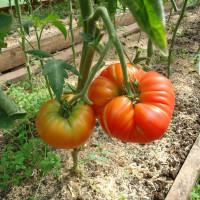Fungicide «Copper sulfate» - an antiseptic and fungicidal agent intended for spraying fruit and berry, ornamental trees and shrubs against scab, moniliosis, anthracnose and other diseases, as well as for disinfecting wounds in fruit trees.
Active ingredient of «Copper sulfate»: copper sulfate, 980 g/kg, soluble powder.
Scope of application of copper sulfate
Copper sulfate is used as a microfertilizer to replenish copper deficiency in the soil. Recommended for use on peat bogs where copper content is low. Another direction of application of copper sulfate is its use for the prevention and treatment of plant diseases and the control of insect pests. Copper sulfate is used as an independent remedy and with lime as part of the Bordeaux mixture.
Using copper sulfate as a fertilizer: copper sulfate is applied once every 5-6 years in early spring or autumn (it is an alternative to pyrite cinder), consumption 1 g per 1 sq.m. Before use, it must be crushed well and mixed with soil. For foliar feeding of vegetative plants, the dose is 1-2 g of copper sulfate per 10 liters of water.
Consumption of copper sulfate: one teaspoon holds 6 grams.
Culture: Apple, Pear, Quince.
Pest: scab, phyllosticosis and other spots, moniliosis, drying out.
Consumption of the drug: 100 g per 10 liters of water
Consumption of working solution: early spring spraying before bud break 2-5 l per tree
Culture: Apricot, Peach, Plum, Cherry, Cherry.
Pest: clasterosporosis, coccomycosis and other spots, moniliosis, curlConsumption of the drug: 50-100 g per 10 liters of water.
Consumption of working solution: early spring spraying before bud break 2-5 l per tree.
Crops: Gooseberries, Currants.
Pest: anthracnose, septoria and other spots.
Consumption of the drug: 50-100 g per 10 liters of water.
Consumption of working solution: early spring spraying before buds open, up to 1.5 liters per bush.
The use of copper sulfate against insect pests and plant diseases (anthracnose, septoria, spotting, phyllostictosis, rot):
- For early spring spraying before bud break against fungal diseases: scab, black cancer, fruit rot, cytosporosis, septoria, brown leaf spot, anthracnose of apple, pear, ornamental and other plum pockets, diseases on cherries, peach leaf curl. Consumption: 100 g - 10 l of water
- For disinfection by immersing in the solution for 3 minutes, followed by abundant rinsing with water: roots of seedlings after removing growths of root bacterial cancer, gooseberry cuttings, currants, raspberry shoots against anthracnose, powdery mildew of strawberries (strawberries) against powdery mildew of aerial parts of gooseberries, currants after pruning diseased parts against powdery mildew. Consumption: 100 g - 10 l of water.
- To disinfect the soil by watering against diseases: black leg of cabbage, tomato gray and white rot of tomato fusarium or yellow cabbage, radish, turnip, rutabaga. Consumption: 5 g – 10 l of water.
- For disinfection of wounds of fruit trees. To disinfect wounds on fruit trees, an aqueous solution is prepared at the rate of 100 g per 10 liters of water. To combat root bacterial cancer in fruit trees and roses, immerse the root after removing growths for 2-3 minutes in a 1% solution, followed by washing them with water.
- For spraying before planting: potato tubers against late blight. Consumption: 2 g – 10 l of water.
- For spraying during the growing season (development): Late blight of tomato, potato. Consumption: 20 g – 10 l of water.
Precautions when working with copper sulfate: follow general safety requirements and personal hygiene rules, use gloves, goggles, a respirator or a cotton-gauze bandage.
After work, you should wash your hands and face with soap and rinse your mouth.
First aid for poisoning (first aid):
- If the drug gets on your skin, rinse the contaminated area with water.
- In case of contact with eyes, rinse immediately with plenty of water and consult a doctor for advice (it is advisable to have instructions for use with you).
- If accidentally swallowed, if signs of poisoning appear: nausea, drooling, metallic taste in the mouth, vomiting, abdominal pain, immediately call a doctor or take the patient to a doctor. Before visiting the doctor, rinse your mouth with water after vomiting. Do not use castor oil as a laxative or emetic!

No questions about this product, be the first and ask your question.













